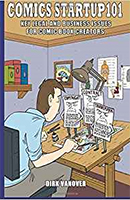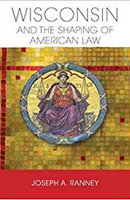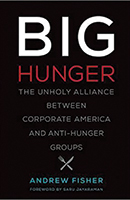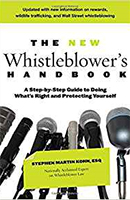 VERDICT: It’s a Keeper
VERDICT: It’s a Keeper
Comics Startup 101: Key Legal and Business Issues for Comic Book Creators
By Dirk Vanover (CreateSpace Independent Publishing Platform, 2017). 68 pgs. $6.00 (paperback), $5.00 (e-book). Order, www.amazon.com.
Reviewed by Jennifer L. Amundsen
Holy self-help guide, Batman! Comics Startup 101: Key Legal and Business Issues for Comic Book Creators, by Wisconsin lawyer Dirk Vanover, aims to provide a helpful guide to the legal issues involved in creating a new comic book or other business venture the reader might start. Thus, it is organized topically – and logically – in the order in which the author envisions the issues will arise. The book touches on the basics of choosing an entity and incorporating but primarily devotes itself to helping the comic creator avoid pitfalls associated with a lack of attention to intellectual property and contracts.
The author explains the legal concepts in plain English to the extent possible, helping to keep the discussion accessible to the target audience of nonlawyers. He obviously enjoys providing examples drawn from within the comic book industry, which help to liven up the material by bringing in familiar characters and industry celebrities. That being said, the generous list of endnotes would be more useful if it were heavier on references to things such as governmental websites related to the subject matter and lighter on legal citations, which the lay reader will almost certainly ignore. A selected bibliography collecting useful resources could help to alleviate that concern and would enhance the book’s value as a reference.
Want to Review a Book?
Please request a book and writing guidelines from Wisconsin Lawyer managing editor Karlé Lester, at klester@wisbar.org or (608) 250-6127. Reviewers may keep the book reviewed. Reviews of about 500 words are due within 45 days of receiving the book. Reviews are published, space permitting, in the order received and may be edited for length and clarity.
The appendix contains a sample work-made-for-hire agreement, in which the comic creator engages an artist to create pages for his or her new comic, and the book’s final substantive chapter is dedicated to analyzing that document. The analysis primarily covers the sections that are likely to be controversial or require negotiation and offers some good insights for the artist or business person who is likely to be a novice at preparing and negotiating a contract.
Puzzlingly, though, the author critiques the sample document. First, he states that certain language ought to be modified before use as it is currently mooted by other language in the agreement, and second, he notes that the sample document omits language regarding confidentiality, which should usually be included in such an agreement. I agree on both counts, but the sample would be more useful to the reader if the author had modified it before publication rather than simply commenting on its shortcomings.
This book provides a useful roadmap for the comic creator or a person starting a business in another creative industry but could have benefitted from some thoughtful editing along the lines mentioned above. Further, the included anecdotes could make this an enjoyable read for any lawyer who is also a comic fan, even if not in the process of creating a new comic book.
Jennifer L. Amundsen, U.W. 2003, is principal of Amundsen Law Firm LLC, Madison. She works in the areas of intellectual property (with a focus on trademark and copyright law) and business law, primarily assisting businesses and entrepreneurs in the information technology and creative industries.
 VERDICT: It’s a Keeper
VERDICT: It’s a Keeper
Wisconsin and the Shaping of American Law
By Joseph A. Ranney (Madison, WI: U.W. Press 2017). 320 pgs. $40.95. Order, https://uwpress.wisc.edu.
Reviewed by Frank R. Briscoe
The history lesson provided by Joseph A. Ranney in his recently published Wisconsin and the Shaping of American Law reminded me of the phrase, “same old same old.” I am not referring to his message. If you have any love of history, the law, or both, you will enjoy the book.
I am referring to how well our public policy makers, judges, and lawmakers get along. From arguing long ago over the proposed Wisconsin Constitution language addressing married women’s property rights, to recent “expressive individualism” in our courts, much has changed, but not our ability to argue over almost everything. Ranney concludes that “consensus began eroding in many states during the late twentieth century...” and briefly mentions the Wisconsin Supreme Court’s current situation as an example. I don’t disagree with his conclusion and believe there hasn’t been much consensus throughout our country’s history.
My favorite chapter, and it was hard to choose, was chapter 6, “Absolute Common Ground.” Chapter 6 covers topics ranging from Lavinia Goodell’s determination to “…practice law in an age when women lawyers were nearly nonexistent” (approximate year, 1870) to the “new nativism” during World War I and Wisconsin’s 1918 legislative effort to suppress active war resistance. Unlike many states, Wisconsin’s new law had a sunset clause, meaning the law automatically terminated after the war ended.
This is a history book and not a tool to disseminate Ranney’s political beliefs. This made the book much easier to read and digest. All the issues addressed, including the development of our laws related to the timber industry, water rights, and land control, inform the reader in such a way that both lawyers and those lucky enough not to be lawyers will understand. (That was a joke. I am proud to be a Wisconsin attorney!) Thanks to Ranney, I now think of Wisconsin’s own Increase Lapham, and his impact on U.S. forest conservation efforts, in a different light as I bike up Lapham Peak located in Waukesha County.
I wanted Ranney to compare the past and current legal and public policy discourse, and he did so. In one chapter addressing the “Progressive Era,” he provides insight into how changes to the Wisconsin Constitution from the early 1900s affected recent events involving Wisconsin’s and Ohio’s new collective-bargaining laws. If you are interested in Ranney’s insight, check out chapter 8, “Breaking the Procrustean Bed.”
Wisconsin stood up to the federal government in 1854, “… when supreme court justice Abram Smith declared … the federal Fugitive Slave Act was unconstitutional….” If the reasoning and influence of that position interests you, read Wisconsin and the Shaping of American Law. You will not regret it.
Frank Briscoe, William Mitchell 1985, works for a national property-casualty insurer in its complex commercial automobile casualty group.
 VERDICT: Touchdown!
VERDICT: Touchdown!
Big Hunger: The Unholy Alliance Between Corporate America and Anti-Hunger Groups
By Andrew Fisher (Cambridge, MA: The MIT Press, 2017). 360 pgs. $29.95. Order, mitpress-orders@mit.edu.
Reviewed by Emily L.R. Wilson
In America, “hunger” as a societal issue is at the forefront of social consciousness. As author Andrew Fisherpoints out, many of us know people struggling to feed their families, and many of us have a sense of fairness or spiritual beliefs that lead us to reject a social Darwinist approach to the issue of food security. Almost all Americans acknowledge access to food as something akin to a basic human right, “… not just a legal entitlement as much as it is a political and moral claim.”
That hunger is a known and pervasive issue, even in this nation of plenty, makes it even more incredible that the problem has been “largely static” since the early 1980s, when a perfect storm of job loss, economic recession, and cuts in federal spending led to a national food crisis and the creation of food charities, thereby placing solutions to hunger firmly within the private sector.
While most people agree that no one should go hungry, we do not agree on a solution to the problem. Fisher contends that we throw away copious resources on stopgap solutions, feeding people for a day or a week, but never really addressing the underlying causes: gender and wage gaps, entrenched racism, lack of access to healthcare and education, and, more generally, systemic poverty.
Meanwhile, the organizations created in the name of eradicating hunger have become more numerous, more powerful, and more greedy. Many of these food banks, Fisher states, have highly paid staff, corporate boards, and CEOs. Wholly dependent on the money they receive from corporate benefactors and with a sometimes explicit understanding that the organizations will not act contrary to the interests of their donors, food charities “feed the need” instead of focusing on responsible social- and economic-justice policy advocacy, public education, and community building.
Most of these organizations, Fisher contends, measure their success by how much food they distribute, rather than by any crucial changes in environment and behavior that would signal a positive effect on hunger’s underlying causes.
Big Hunger presents a lot of what would otherwise be fairly dry subject matter in an easily accessible and engaging way. It reads partly as an exposé, partly as a history, and largely as a sociopolitical commentary. It also offers numerous and thoughtful recommendations as potential solutions to complex problems with food access. This forward-looking approach differentiates it from more reductive works that glaringly spotlight the negative, without the courage to propose meaningful alternatives.
Fisher’s bottom line is that charity is not a substitute for justice. He pleads with national hunger groups to choose a new path. Closing the hunger gap will require effort, innovation, education, leadership, and cooperation – the creation of a movement, for the benefit of our national future. Whether we will collectively undertake this noble challenge is unknown, but Big Hunger leaves the reader hopeful that we will choose wisely, in pursuit of a better world.
Emily L.R. Wilson, CUNY School of Law 2011, practices family law at Kowalski Family Law LLC, Madison.
 VERDICT: Touchdown!
VERDICT: Touchdown!
The New Whistleblower’s Handbook: A Step-by-Step Guide to Doing What’s Right and Protecting Yourself
By Stephen M. Kohn (Guilford, CT: Lyons Press, 2017). 550 pgs. $22.95. Order, www.whistleblowers.org.
Reviewed by Lori Kornblum
What a surprise and pleasure to open The New Whistleblower’s Handbook and find a well-written, interesting narrative that also is suffused with extremely practical information. This book is an updated version of the original book, The Whistleblower’s Handbook, written by the same author, Stephen Martin Kohn, and published in 2011. An expert in whistleblower’s law, Kohn also wrote a litigation guide for whistleblowers’ lawyers that was published in 1991 and updated in 1994.
The book’s two key themes are first, do not become a whistleblower without first intending to do so; and second, as Kohn writes in the Introduction, “No one should read this handbook and conclude, ‘Voila – I can win my case!’ If only life were so simple….”
This book is intended to guide the potential whistleblower and encourage anyone contemplating blowing the whistle to do some research. Kohn has a lot of information focused on the do’s and don’ts for potential whistleblowers.
This book also is intended to guide plaintiffs’ lawyers (although one might be tempted to just refer all cases to Kohn). For lawyers representing employers, the book is a great insider’s guide to how the plaintiff’s bar is thinking.
The book digs deep into whistleblower law. The author details all the federal and state statutes pertaining to whistleblowers and annotates them with the key cases interpreting those laws. He describes in his narrative chapters how the laws work in practice. Kohn provides scores of painful examples of what goes right and wrong in whistleblower litigation.
Kohn provides more than 100 pages of practical guidance in the form of eight different checklists that a lay person or lawyer can use to hone in on best practices. One could get the book and just use the checklists as a reference. However, I would advise reading the narrative chapters, called “Rules,” numbered 1-31, plus an international toolkit. The reader can focus on the chapters that appear most appropriate. Kohn appears to assume that readers will not read the book cover to cover so he discusses many of the main whistleblower laws in several chapters.
Kohn focuses on the Federal False Claims Act in several chapters, highlighting its effectiveness based on individual awards as a percentage of recovery and the ability of litigants to sue in the name of the government (qui tam). He stresses that the Act and similar reward-based laws do much more to protect whistleblowers and recover funds than the older model of laws, based on employment law remedies for whistleblowers who lose their jobs.
In short, I highly recommend this book for anyone who does whistleblower law, is thinking about doing it, knows someone who may become a whistleblower, or just wants a good read on an interesting subject.
Lori S. Kornblum, UC-Berkeley 1982, is a tenured faculty member at Milwaukee Area Technical College, Department of Paralegal Studies; an adjunct faculty member, Marquette University Law School; and in private practice focusing on child abuse and neglect, private termination of parental rights, and adult guardianship and disability issues.
